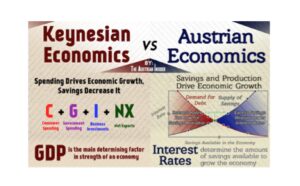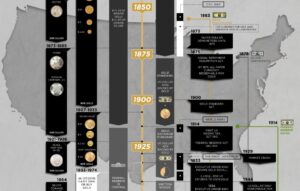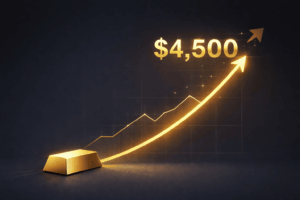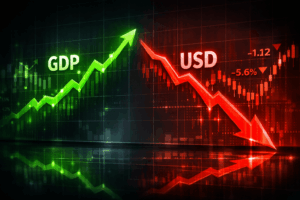The spot price of gold is based on the price of one troy ounce of gold on international exchanges.
Gold spot prices refer to the “bid” price you see listed—which is the price most recently quoted in the market that buyers are willing to purchase at. This is usually lower than the “ask” price sellers are currently seeking.
The spot price is based on trading activity in the futures markets. It is an international standard for the spot price of gold to be quoted in US dollars. In the US, the COMEX is the primary exchange where gold is traded and where the spot price is set. While trading of actual physical metal occurs on most exchanges, the bulk of trading is done through futures contracts or other derivatives.
Gold is traded in many different international markets. That means that while each market has set times it is open and closed, gold is almost always available for trading somewhere in the world.
This constant trade also means the spot price of gold is continually changing. The spot price fluctuates during trading days, depending on what buyers and sellers are doing.
The London Bullion Market Association (LBMA) also provides a “fix” price twice per trading day. The fix price is a benchmark for large institutions, producers, and other major market participants when pricing contracts. Retail customers typically cannot buy and sell based on the fix price and only use the spot price.
These same processes apply to the silver spot price as well.
Can I Buy Gold at the Spot Price?
No, it is not possible to buy gold at the spot price. The spot price is for “unfabricated” metal. There are always additional premiums that cover forming gold into a coin or bar.
Any transaction you make in the gold market uses the spot price as a starting point. Your final cost will depend on the form of gold you buy. The lowest premium items are gold bars. Gold coins have a slightly higher premium since they have more intricate designs. Gold jewelry is the most expensive given the craftsmanship involved (though you can buy “bullion jewelry” comprised solely of gold, which avoids the high mark-up of most costume jewelry today).
All dealers charge a premium over the spot price. Here’s how to find a reputable dealer with competitive premiums, along with advice on what to buy.

What Makes the Spot Price Move Up or Down?
At the most basic level, the spot price of gold depends on the balance between supply and demand within the international market. If many people are selling, or there is a large spike in mining and manufacturing, the supply of gold increases, and the spot price will go down. However, if many people are looking to invest in gold, this creates a high demand in the market, and the spot price of gold will go up.
Ordinary purchasing and liquidation activity, along with speculation, typically make for the minute-by-minutes changes to the spot price.
There are also big-picture forces that can influence buyers and sellers. These catalysts tend to have the greatest impact on the gold price.
US Dollar
The dollar and gold tend to be inversely correlated (when the dollar rises, gold falls, and vice versa). While the behavior of any currency can impact gold prices, the US dollar is the most important since gold is universally priced in dollars.
Inflation
Known as perhaps the greatest inflation hedge throughout history, gold tends to rise during periods of inflation or even when there are predictions of inflation.
Interest Rates
Gold and interest rates are generally inversely correlated (when rates rise, the spot price of gold lowers). However, the “real” rate (prevailing interest rate minus inflation) is more important than the rate itself.
Stock Markets
Gold and the stock market are also inversely correlated. When investors are excited about stocks, they tend to buy less gold. When the stock market is falling and they’re fearful, they tend to buy more gold.
Central Banks
The activity of central banks—from money printing to buying or selling physical gold—can influence gold prices. Because there is a global commodity market for gold, every central bank can affect the spot price, with more powerful economies able to create a more significant impact.
Crises
Virtually any type of crisis—a terror attack, political upheaval, even a recession—can affect the spot price of gold. Gold is universally known as a safe haven for investing. Any event that causes fear or uncertainty can push gold prices higher.
Commodities
Gold is more “money” than a commodity, but since it has industrial and jewelry use, the price can be impacted by how commodities in general are performing.
The gold market is relatively small compared to other markets, so the price can be more easily impacted by small amounts of money entering or leaving the sector.
What Is the Gold Price Right Now?
You can see the current gold price and watch its daily movements. You can even view historical prices with our interactive chart, along with how it’s performing in relation to other assets.
What Is the Gold Price In My Local Currency?
Gold is priced in US dollars around the world. However, investors in non-US countries can convert the US price to their local currency to reflect its value in that unit of currency.
There have been times when, due to changes in a currency’s value, the gold price in another currency may rise or fall more than the US dollar price—or even move in the opposite direction. In 2019, for example, the gold price hit all-time highs in dozens of currencies, except the US dollar.
Why Is the Gold Price So High?
To those new to the market, the gold price might seem high for just one ounce. But this shows how much value investors around the world put on it. Gold has some use as a commodity—in medicine and as jewelry, for example—but its primary use is as a store of value. This has been its primary use for thousands of years.
Gold Price Trends
In general, gold has consistently increased in value over time and followed market trends. But it’s important to look at some of the smaller details within the market.
No matter what you choose to invest in, there is always a chance for volatility and risk. Volatility is the swing in the evaluation of your investment. Highly volatile markets will quickly change from having record highs to having record lows, while more stable markets will have less variation.
In the short term (6 months or less), the spot price of gold can be volatile. If you look at the gold price charts over the past six months, you will see that the spot price has gone up and down with multiple peaks and valleys. However, the short-term volatility of gold does not reflect its long-term stability. Gold price over time has shown stable growth with only a slight peak and crash around 2011 to 2012, mirroring the state of the economy at the time.
When it comes to risk, gold is considered one of the safest investments. Even if there is a total economic collapse, gold has historically shown to retain its value.
When Is the Best Time to Buy Gold?
Just like the best time to buy chocolates is February 15th (the day after Valentine’s Day), there are good and bad times to buy gold. There are trends to the price of gold, and to get the most gold for your dollar, you want to buy when the prices are low.
The spot price for gold tends to have a brief rise at the start of the year, cools off during the spring and summer, and then spikes through the fall and winter. According to past trends, the best time to buy gold is March.
Start Investing with GoldSilver
GoldSilver makes it easy for everyone to start investing. Our secure online store offers affordable gold bars and coins with low premiums. Start your gold investment today!








